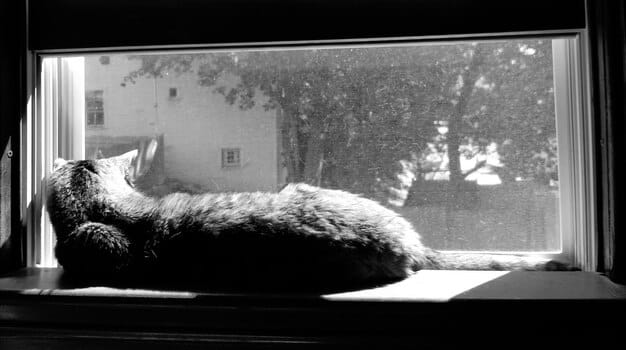Seasonal Affective Disorder in Pets: How it Manifests

Seasonal Affective Disorder (SAD) can affect domesticated animals, manifesting through behavioral changes such as lethargy, decreased appetite, and altered sleep patterns, primarily during cooler, darker months.
As the days shorten and the chill of winter sets in, many of us notice a shift in our own moods and energy levels. But have you ever considered how these seasonal changes might impact your furry companions? The question of How Does Seasonal Affective Disorder Manifest in Domesticated Animals? delves into a fascinating area of animal behavior and well-being, exploring whether our pets, much like humans, can experience a form of seasonal blues.
Understanding Seasonal Affective Disorder in the Animal Kingdom
Seasonal Affective Disorder (SAD), often associated with humans, is a type of depression that recurs at certain times of the year, typically during autumn and winter. It is largely linked to reduced exposure to natural light affecting serotonin levels and melatonin production. While research on SAD specifically in domesticated animals is less extensive than in humans, observational evidence and veterinary insights suggest that our pets can exhibit similar seasonal shifts in behavior and mood.
The concept of seasonality in animal biology is not new. Many species, particularly those in the wild, adjust their behaviors, metabolism, and reproductive cycles in response to changes in daylight and temperature. Domesticated animals, despite living in controlled environments, retain some of these innate biological rhythms. The key difference lies in how these rhythms interact with their human-centric lifestyles and the potential for these natural adaptations to manifest as what we might perceive as “disorder.”
The Biological Basis of Seasonal Changes
Much like humans, animals possess a circadian rhythm, an internal clock regulated by the light-dark cycle. This rhythm influences hormone production, sleep patterns, and overall activity levels. When daylight hours decrease, some animals may experience:
- Melatonin Production: Increased melatonin levels, a hormone that induces sleep, can lead to lethargy and prolonged rest.
- Serotonin Fluctuations: Lower levels of serotonin, a neurotransmitter associated with mood and happiness, potentially contributing to depressive behaviors.
- Vitamin D Deficiency: Reduced outdoor time and sunlight exposure can affect Vitamin D synthesis, impacting bone health and mood regulation.
These biological shifts are a natural part of their adaptability to changing seasons. However, in a domestic setting, where expectations for activity and social interaction remain constant regardless of the season, these shifts can become problematic, leading to behaviors that owners might worry about. Understanding this biological foundation is crucial for discerning what truly constitutes SAD versus normal seasonal adjustments in pets.
The challenge lies in differentiating between a natural, albeit pronounced, seasonal change in behavior and a clinical manifestation akin to human SAD. Owners might notice their pet becoming less playful, sleeping more, or showing reduced interest in activities they once enjoyed. These changes, if severe and persistent, warrant a closer look, especially if they impact the animal’s overall quality of life.
Recognizing the Signs: Behavioral Manifestations
When considering How Does Seasonal Affective Disorder Manifest in Domesticated Animals?, observing changes in behavior is paramount. Pet owners are often the first to notice subtle shifts in their animal’s routine and demeanor. These manifestations can vary widely depending on the individual animal, its species, breed, and general disposition, but there are common patterns that emerge during the darker months.
Lethargy is perhaps one of the most frequently reported signs. Animals, particularly dogs, who were once eager for walks and playtime, might seem less enthusiastic. They may spend more time sleeping or simply lying around, even when given opportunities for activity. This reduced energy isn’t just about longer nights; it can also be a lack of interest in their usual routines.

Common Behavioral Indicators
Beyond general lethargy, several specific behaviors might indicate a seasonal impact on your pet’s mood:
- Changes in Appetite: Some animals may show a decreased interest in food, while others might exhibit an increase, possibly as a coping mechanism or due to slower metabolism.
- Increased Sleep Duration: While some extra sleep is normal during winter, an excessive increase, far beyond their usual patterns, could be a red flag.
- Reduced Playfulness: A previously playful pet might show less enthusiasm for toys, games, or interaction with family members.
- Social Withdrawal: Animals might seek less attention, prefer to be alone, or avoid interactions with other pets or people.
- Irritability or Anxiety: Some pets may become more vocal, destructive, or display signs of anxiety, such as excessive licking or pacing, possibly due to a disruption in their internal balance.
These signs are not always definitive of SAD, as they can also indicate other underlying health issues. Therefore, it is crucial to consult with a veterinarian to rule out any medical conditions before attributing changes solely to seasonal influences. Keeping a detailed log of your pet’s behavior can be incredibly helpful for your vet in making an accurate assessment.
It’s important to remember that these changes are often subtle at first and can progress over time. A keen owner who knows their pet’s normal habits will be best positioned to identify these shifts early. The manifestations are rarely dramatic overnight but rather a gradual evolution in their seasonal behavior patterns.
Species-Specific Considerations: Dogs, Cats, and Smaller Pets
The impact of seasonal changes, and how they might manifest as something akin to SAD, varies across different domesticated species. Each animal has its unique physiology and behavioral patterns, influencing how they respond to environmental shifts, particularly changes in light exposure. Understanding these species-specific nuances is crucial when addressing How Does Seasonal Affective Disorder Manifest in Domesticated Animals?
Dogs: Highly Sensitive Companions
Dogs are perhaps the most commonly discussed when it comes to seasonal mood changes, largely due to their close interaction with humans and their typically gregarious nature. Their reliance on outdoor activities and structured routines means changes in daylight hours and weather can significantly impact their well-being. Common manifestations in dogs include:
- Decreased Energy: Reduced enthusiasm for walks, fetching, and other forms of exercise.
- Increased Sleeping: Dogs may sleep more deeply and for longer periods during the day.
- Loss of Interest: Less interaction with toys, family members, or other pets.
- Behavioral Changes: Some dogs might become more irritable, restless, or even exhibit house-soiling if their routine is disrupted.
Breeds can also play a role; high-energy working breeds might show more pronounced signs of boredom or frustration if their activity needs are not met during shorter, colder days. Similarly, dogs prone to anxiety might find the dimming light exacerbates their existing conditions.
Cats: Subtle Shifts in Feline Friends
Cats, often perceived as more independent, can also be affected, though their signs might be more subtle and easily overlooked. Their natural instinct to conserve energy during colder months can sometimes mimic depressive symptoms. Manifestations in cats often include:
- Excessive Sleeping: Even more than usual, cats may spend the majority of their time napping.
- Reduced Affection: Less desire for petting or social interaction with owners.
- Decreased Playfulness: Lack of interest in chasing toys or engaging in predatory play.
- Changes in Grooming: Some cats might groom excessively, while others may neglect their grooming habits.
Indoor-only cats might be particularly susceptible, as their exposure to natural light is often limited, regardless of the season. Owners might need to be more proactive in observing and stimulating their indoor felines during winter months.
Smaller Pets: Rodents, Birds, and Reptiles
While less research focuses on SAD in smaller pets, they are not immune to seasonal influences. Many small animals, like hamsters or gerbils, naturally enter states of torpor or reduced activity in response to colder temperatures and less light, which can be mistaken for depression. Birds can also be affected by diminished light, leading to changes in singing patterns, activity levels, and even feather plucking due to stress. Reptiles, being ectothermic, are highly dependent on external heat and light sources, and insufficient provision during winter can lead to lethargy, appetite loss, and other health issues.
- Rodents: May exhibit reduced activity, increased hiding, and less interest in their exercise wheels.
- Birds: Can show changes in vocalizations, feather condition, and overall energy.
- Reptiles: Highly sensitive to temperature and light cycles, often requiring specific lighting elements to mimic natural conditions, preventing brumation or lethargy during colder periods.
For all species, the key is to understand their natural biological rhythms and distinguish them from signs of distress. Environmental enrichment and consistent access to appropriate light are vital in mitigating potential seasonal challenges for these smaller companions.
Environmental Factors and Lifestyle Adjustments
The environment in which our domesticated animals live plays a significant role in how seasonal changes might affect them. Understanding the connection between external factors and internal well-being is crucial when exploring How Does Seasonal Affective Disorder Manifest in Domesticated Animals? and, more importantly, how we can mitigate its effects. Lifestyle adjustments can often make a profound difference in buffering pets from the impacts of reduced daylight and colder temperatures.
The primary environmental factor impacting seasonal mood is light exposure. Natural sunlight is a powerful regulator of circadian rhythms, influencing hormone production and neurotransmitter balance. During autumn and winter, shorter daylight hours mean pets, especially those spending most of their time indoors, receive less natural light. This can lead to imbalances that contribute to symptoms resembling SAD.
Optimizing Light Exposure
One of the most effective ways to counteract seasonal changes is to increase light exposure. This doesn’t necessarily mean buying expensive equipment; simple adjustments can be quite impactful.
- Strategic Placement of Beds/Areas: Position pet beds or frequented areas near windows where natural light is abundant. Ensure blinds and curtains are open during the day.
- Outdoor Time: Maximize outdoor time during daylight hours, even on cloudy days. The intensity of outdoor light, even diffused, is significantly higher than indoor artificial light.
- Light Therapy: For severe cases, full-spectrum light therapy lamps designed for pets (or humans, used safely) can be beneficial. These lamps mimic natural sunlight and can help regulate sleep-wake cycles and mood. Consult with a veterinarian before initiating light therapy.
Beyond light, temperature and overall indoor environment also contribute. Keeping homes adequately warm and comfortable, without being excessively stifling, is important for many species, especially those less tolerant of cold.
Enhancing Daily Routines and Enrichment
Maintaining a consistent routine throughout the year can provide stability for pets. While the weather might dictate shorter or fewer walks, finding alternative ways to provide mental and physical stimulation is key.
- Consistent Exercise: Adjust indoor exercise. Use puzzle toys, indoor agility courses, or interactive games to keep pets engaged. For dogs, consider indoor dog parks or training classes.
- Mental Stimulation: Boredom can exacerbate seasonal lethargy. Incorporate new training commands, scent work, or food puzzles to keep their minds active.
- Social Interaction: Continue to provide ample social interaction with family members and other friendly pets. Isolation can worsen feelings of withdrawal.
Dietary considerations can also play a role, though less directly linked to SAD. Ensuring a balanced diet and adequate hydration always supports overall well-being. Some owners explore supplements like Omega-3 fatty acids, but any dietary changes or supplements should be discussed with a veterinarian.
The goal of these adjustments is to create an environment that minimizes the disruptive effects of changing seasons, promoting consistent physical activity and mental engagement regardless of the external conditions. These proactive measures can significantly contribute to maintaining your pet’s emotional and physical health year-round.
The Role of Veterinary Care and Professional Support
While owners are often the first to notice changes in their pets, understanding How Does Seasonal Affective Disorder Manifest in Domesticated Animals? and addressing it effectively often requires professional veterinary guidance. A veterinarian can not only confirm or rule out SAD but also provide tailored advice and intervention strategies. Self-diagnosis and treatment are rarely advisable, as many symptoms of seasonal mood changes can overlap with more serious health conditions.
The initial step should always be a comprehensive veterinary check-up. This allows the vet to perform diagnostic tests to exclude underlying medical issues such as thyroid problems, pain, or other systemic diseases that might mimic symptoms of lethargy, appetite changes, or behavioral shifts. Once general health is confirmed, the discussion can then shift towards behavioral and environmental factors. The veterinarian can help distinguish between normal seasonal variation and true signs of distress or a disorder.
When to Consult a Veterinarian
Consider a veterinary visit if your pet exhibits:
- Sudden or Drastic Behavioral Changes: Especially if they impact their eating, drinking, or elimination habits.
- Prolonged Lethargy: If your pet sleeps excessively and is difficult to rouse or shows no interest in their usual activities for more than a few days.
- Aggression or Anxiety: New onset of irritability, destructive behavior, or signs of anxiety like excessive vocalization or pacing.
- Weight Changes: Significant loss or gain of weight without changes in diet.
A vet can help you understand the potential impact of light deficiency on your pet’s neurochemistry and guide you on appropriate interventions. They can also provide a realistic perspective on what constitutes a problem versus a natural seasonal adjustment for your specific pet.
Therapeutic Approaches and Support
Depending on the severity of the symptoms and the animal’s overall health, a veterinarian might recommend several therapeutic approaches:
- Light Therapy: As mentioned, specific full-spectrum light boxes can be a treatment option. Vets can advise on the correct type, duration, and proximity for safe and effective use.
- Environmental Enrichment Plans: Your vet might work with you to develop a daily routine that maximizes light exposure, physical activity, and mental stimulation. This could include recommendations for puzzle toys, training, or interactive play.
- Dietary Adjustments/Supplements: In some cases, a veterinarian might suggest specific dietary changes or supplements, such as Omega-3 fatty acids, to support brain function and mood. However, these are typically complementary to other treatments.
- Behavioral Modifiers/Medication: For severe cases, particularly if the animal’s quality of life is significantly impacted, a vet might consider prescribing anti-anxiety or antidepressant medication. This is a rare step and usually reserved for cases that don’t respond to environmental and behavioral interventions, and always under strict veterinary supervision.
Navigating seasonal changes in pets is a partnership between owner and vet. Leveraging professional expertise ensures that any interventions are safe, appropriate, and genuinely beneficial for the animal’s long-term health and happiness.
Preventative Strategies and Long-Term Well-being
Proactive prevention is often more effective than reactive treatment when it comes to seasonal changes affecting our pets. Addressing How Does Seasonal Affective Disorder Manifest in Domesticated Animals? also involves understanding how to minimize its occurrence and promote long-term well-being, ensuring our companions remain happy and healthy throughout the year, not just during the sunny months.
The foundation of prevention lies in creating an environment that supports consistent physical and mental health. This means not only responding to changes when they occur but implementing strategies that anticipate seasonal shifts and cushion their impact. A holistic approach focusing on light, activity, diet, and emotional security is key.
Building Resilience to Seasonal Changes
Several strategies can help build a pet’s resilience to seasonal fluctuations:
- Consistent Light Exposure: Install timers on lights to mimic natural sunrise and sunset. Consider smart lighting systems that gradually brighten and dim. Utilize daylight bulbs in key areas.
- Year-Round Activity: Develop an exercise routine that is adaptable to different weather conditions. This might involve more indoor play during winter, but critically, maintaining mental and physical engagement.
- Enrichment Rotation: Introduce new toys, puzzles, and training exercises regularly to keep pets mentally stimulated and prevent boredom, which can worsen seasonal lethargy.
- Social Connection: Ensure your pet continues to receive ample social interaction and affection from family members. Loneliness can exacerbate any feelings of withdrawal.
Preventative measures aren’t just about avoiding SAD symptoms; they’re about enhancing overall quality of life. A pet that is consistently stimulated, loved, and properly cared for is more likely to weather seasonal changes with minimal disruption to their well-being. This ongoing commitment to their holistic health is essential.
Holistic Approaches to Well-being
Beyond direct interventions, considering a pet’s holistic well-being can greatly contribute to their resilience against seasonal dips:
- Balanced Nutrition: A high-quality, balanced diet supports overall physical and mental health, providing the necessary nutrients for brain function and energy.
- Regular Health Check-ups: Routine veterinary visits help catch any emerging health issues early, preventing their symptoms from being misattributed to seasonal changes.
- Safe and Comfortable Environment: Ensuring your pet has a comfortable resting place, access to fresh water, and a secure environment reduces underlying stress.
- Positive Reinforcement Training: Engaging in ongoing positive training builds confidence and strengthens the bond between pet and owner, which can be a buffer against mood changes.
These long-term strategies foster a robust foundation of health and happiness, helping pets navigate the natural ebb and flow of the seasons with greater ease. They represent a commitment to preventative care that goes beyond addressing symptoms and focuses on creating an optimal living environment year-round.
Beyond SAD: Other Seasonal Influences on Pet Behavior
“How Does Seasonal Affective Disorder Manifest in Domesticated Animals?” is a pertinent question, but it’s important to acknowledge that not all seasonal behavioral changes can be attributed solely to SAD. The shift in seasons brings a host of other environmental and social changes that can influence pet behavior, sometimes mimicking SAD symptoms or simply adding to the complexity of an animal’s adjustment. Understanding these broader influences allows for a more nuanced approach to pet care.
For instance, colder weather often means fewer outdoor activities for both pets and their owners. Less frequent walks, shorter playtime in the yard, and reduced opportunities for social interaction with other animals can lead to boredom, pent-up energy, and loneliness. These factors, independent of light exposure, can result in behaviors such as lethargy, destructive tendencies, or increased vocalization. Similarly, holidays often bring disruptions to routine, new people, and different foods, all of which can cause stress or overstimulation in sensitive animals.
Common Seasonal Mimics of SAD
- Reduced Exercise Opportunities: Icy conditions, heavy snow, or even just cold rain can limit outdoor activity. This leads to an excess of unused energy, which might manifest as restlessness or, conversely, a resigned lethargy due to a lack of appropriate outlets.
- Boredom and Lack of Stimulation: When pets spend more time indoors, especially if owners are also less active, they may not receive enough mental or physical stimulation. This can lead to destructive chewing, excessive barking, or a general malaise that looks like depression.
- Holiday Stress: The holiday season, often coinciding with winter, brings new schedules, guests, travel, and festive decorations. While exciting for humans, these changes can be highly stressful for pets, leading to anxiety, withdrawal, or behavioral regressions.
- Temperature Sensitivity: Some individual pets, particularly those with short coats, older animals, or those with underlying health issues, are genuinely uncomfortable in colder temperatures. Their reluctance to go outside or their general lethargy might be a physical response to cold rather than a mood disorder.
It’s crucial for owners to diligently observe their pets and consider all potential contributing factors to a change in behavior, rather than immediately jumping to a diagnosis of SAD. Keeping a detailed journal of daily activities, weather conditions, and behavioral observations can be immensely helpful for both owners and veterinarians in identifying patterns and pinpointing root causes.
Ultimately, a comprehensive understanding of a pet’s environment, routine, and typical temperament is necessary to differentiate between true SAD, other behavioral responses to seasonal shifts, or even independent health concerns. Addressing the specific underlying cause—whether it’s light deficiency, lack of exercise, stress, or physical discomfort—is paramount for effective intervention and ensuring the pet’s well-being throughout the year.
| Key Aspect | Brief Description |
|---|---|
| ☀️ Light’s Impact | Reduced daylight affects melatonin/serotonin, leading to lethargy and mood shifts. |
| 🐾 Behavioral Signs | Lethargy, increased sleep, changes in appetite, reduced playfulness, social withdrawal. |
| 🏡 Environmental Fixes | Maximize natural light, consistent routines, mental stimulation, and potential light therapy. |
| 🩺 Vet Consultation | Essential to rule out other health issues and discuss tailored intervention strategies. |
Frequently Asked Questions About SAD in Pets
While research is most evident in dogs, and to a lesser extent cats, anecdotal evidence suggests various domesticated species, including smaller pets like birds and rodents, can exhibit seasonal changes in behavior and mood akin to SAD. Their biological rhythms are often tied to light cycles, potentially making them susceptible.
The primary suspected cause is reduced exposure to natural light during shorter autumn and winter days. This lack of light can disrupt the production of hormones and neurotransmitters, such as melatonin and serotonin, affecting an animal’s sleep-wake cycle, energy levels, and mood.
Distinguishing between normal tiredness and SAD involves observing patterns. If lethargy is prolonged, accompanied by appetite changes, social withdrawal, or loss of interest in activities, and consistently recurs during darker months, it might indicate SAD. Always consult a vet to rule out other health issues.
Natural remedies often focus on environmental adjustments: maximizing natural light exposure by opening blinds, ensuring sufficient outdoor time during daylight, maintaining consistent exercise, and increasing indoor mental stimulation with toys or training. Some owners find specific dietary supplements helpful, but always with veterinary guidance.
Yes, light therapy using full-spectrum lamps designed for SAD can be an effective treatment for pets, especially when natural light is limited. It works by mimicking natural sunlight, helping to regulate the pet’s circadian rhythm and hormone balance. However, it should only be used under the guidance of a veterinarian to ensure proper and safe application.
Conclusion
The question of How Does Seasonal Affective Disorder Manifest in Domesticated Animals? opens an important dialogue about the comprehensive well-being of our beloved companions. While not as extensively studied as in humans, the evidence suggests that seasonal changes, particularly reduced light exposure, can indeed impact our pets’ moods and behaviors. Recognizing the subtle signs, from increased lethargy to changes in appetite or social interaction, is the first step. Proactive environmental adjustments, consistent stimulation, and, crucially, timely veterinary consultation are all indispensable elements in ensuring our pets remain happy and healthy year-round, reminding us that their emotional lives are just as complex and deserving of attention as our own.





